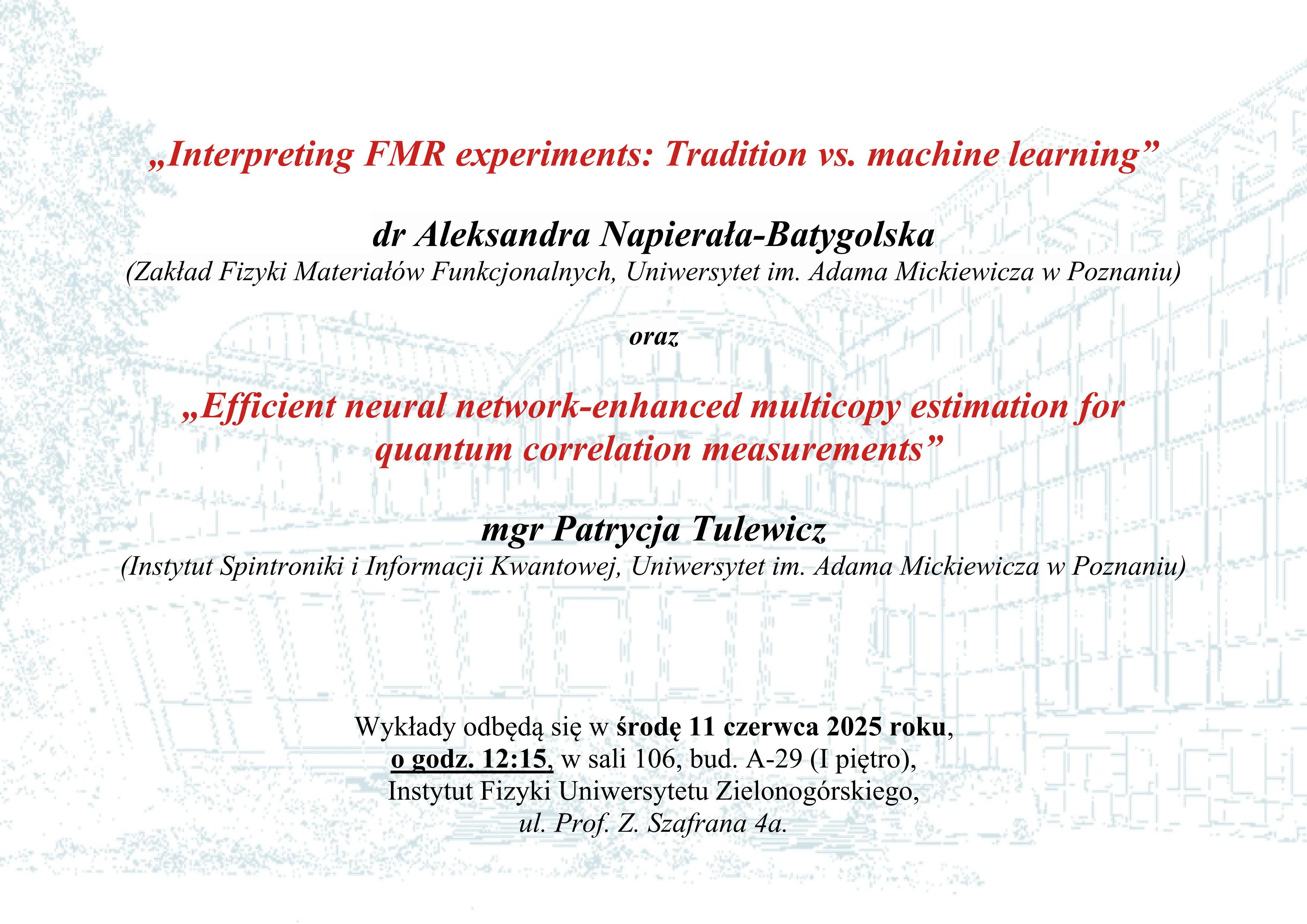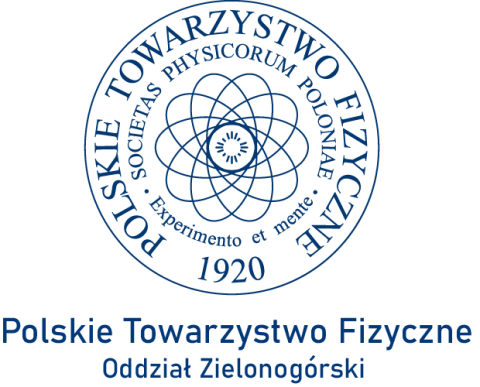Instytutu Fizyki Uniwersytetu Zielonogórskiego wraz z Zielonogórskim Oddziałem PTF zapraszają na dwa wykłady, które odbędą się 11 czerwca 2025 roku o godz. 12:15. w sali 106, bud. A-29 (I piętro) w Instytucie Fizyki Uniwersytetu Zielonogórskiego, ul. Prof. Z. Szafrana 4a. Pierwszy wykład pt. "Interpreting FMR experiments: Tradition vs. machine learning" wygłosi dr Aleksandra Napierała-Batygolska z Zakładu Fizyki Materiałów Funkcjonalnych Uniwersytetu im. Adama Mickiewicza w Poznaniu. Drugi wykład pt. "Efficient neural network-enhanced multicopy estimation for quantum correlation measurements" wygłosi mgr Patrycja Tulewicz z Instytutu Spintroniki i Informacji Kwantowej Uniwersytetu im. Adama Mickiewicza w Poznaniu.
Streszczenie - "Interpreting FMR experiments: Tradition vs. machine learning":
The phenomenon of ferromagnetic resonance (FMR) is still being widely used for determining the magnetocrystalline anisotropy constants of magnetic materials. However, there are three methods of analyzing experimental results: 1. using the Kittel equation [Phys. Rev. 73, 155 (1948)], 2. using the Smith-Beljers equation [Philips Res. Rep. 10, 113 (1955)], and the latest method - using machine learning techniques [Phys. Rev. B 98, 144415 (2018)]. We compare the results of applying these three methods to the analysis of the FMR experiment carried out for magnetite [Phys. Rev, 78, 449 (1950)], epitaxial layers magnetic semiconductor (Ga,Mn)As on (113) GaAs [Phys. Rev. B 81, 155203 (2010), Phys.Rev. B 91, 184403 (2018)] . The results of our analysis indicate that the use of machine learning offers a significant advantage over other approaches, as confirmed in [Scientific Reports, 15, 11277 (2025)]. Our analysis allows us to unambiguously determine the spatial distribution of free energy (and therefore magnetocrystalline energy). This applies in particular to the situation when the FMR measurements were carried out in different crystallographic planes and the directions of the sample’s crystallographic axes do not coincide with the directions of the shape anisotropy. Then the use of machine learning techniques becomes indispensable.
Streszczenie - "Efficient neural network-enhanced multicopy estimation for quantum correlation measurements":
Traditional approaches to quantifying quantum correlations, in particular entanglement and Bell nonlocality, typically rely on quantum state tomography (QST). Although versatile, QST suffers from the problem of exponential scaling, requiring resources that become prohibitive with system size. This limitation is a strong motivation to search for more efficient characterization methods that maintain measurement accuracy while significantly reducing resource requirements.
In this talk, I will present an optimized multicopy estimation (MCE) technique that directly measures quantum correlation properties through specific singlet projection measurements performed on multiple copies of the quantum state. By integrating artificial neural networks into this approach, we have achieved a significant 67% reduction in measurement requirements compared to full QST. Our method maintains high accuracy while demonstrating excellent robustness to noise.
A key innovation in our approach is the use of SHAP (SHapley Additive exPlanations) analysis to identify the minimum set of informative measurements. Through this analysis, we have found that only five strategically chosen projection configurations are sufficient to reliably estimate both entanglement negativity and measures of Bell’s nonlocality. We experimentally verify our method on IBM quantum processors, demonstrating its practical advantages in real quantum hardware environments, where noise is unavoidable, and we have used maximum likelihood to mitigate it.
The neural network component of our system is trained to recognize patterns in the measurement data that correspond to specific quantum correlation properties, further enhancing the robustness of the method to experimental noise and device imperfections. This represents a significant advance over previous approaches that required more complex measurement protocols or were more susceptible to noise-induced errors.
We further demonstrate the utility of our method by applying it to benchmark distributed quantum computing (DQC) architectures, where it effectively captures how network topology and system parameters affect entanglement preservation. This application demonstrates the versatility of our approach for practical quantum system characterization where measurement resources are limited.
References
[1] P. Tulewicz, K. Bartkiewicz, A. Miranowicz, and F. Nori, Resource-Efficient Quantum Correlation Measurement: A Multicopy Neural Network Approach for Practical Applications (2024). arXiv:2411.05745
[2] K. Bartkiewicz, G. Chimczak, and K. Lemr, Direct method for measuring and witnessing quantum entanglement of arbitrary two-qubit states through Hong-Ou-Mandel interference, Phys. Rev. A 95, 022331 (2017).
[3] K. Bartkiewicz and G. Chimczak, Two methods for measuring Bell nonlocality via local unitary invariants of two-qubit systems in Hong-Ou-Mandel interferometers, Phys. Rev. A 97, 012107 (2018).
Acknowledgements: This work was funded by the Polish National Science Center from funds awarded through the Maestro Grant No. DEC-2019/34/A/ST2/00081, and the European Union’s Horizon Europe research and innovation programme under grant agreement No. 101102140 – QIA Phase 1.



